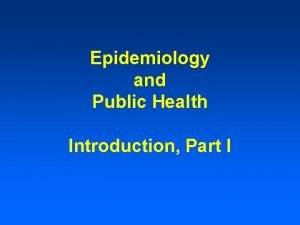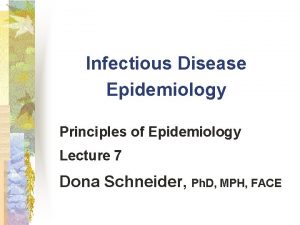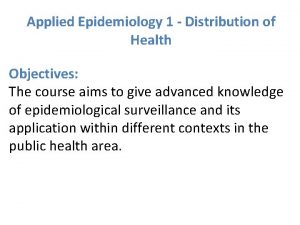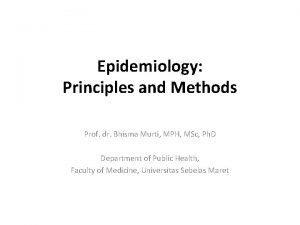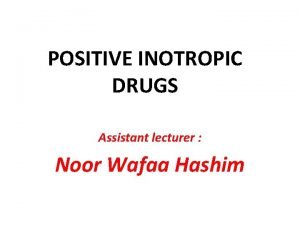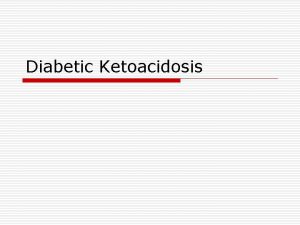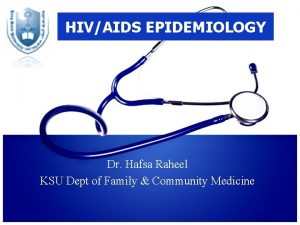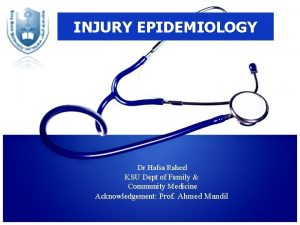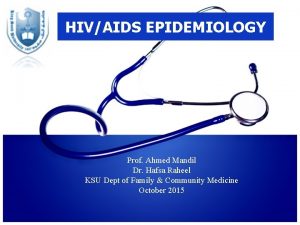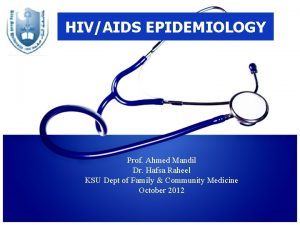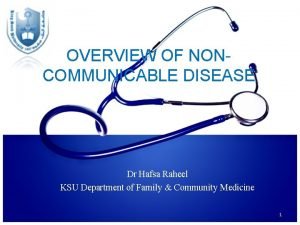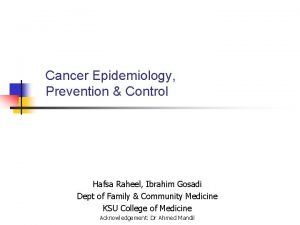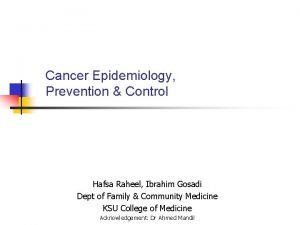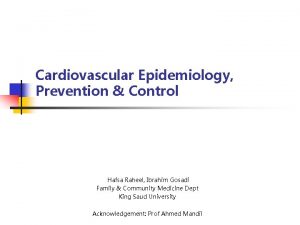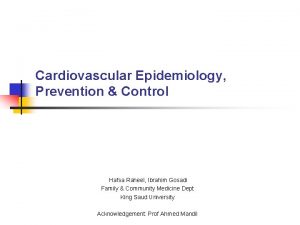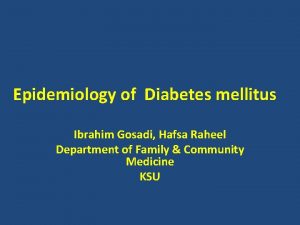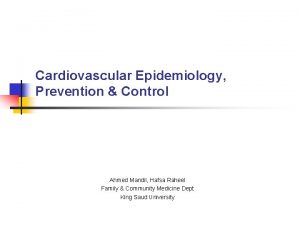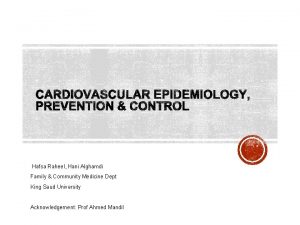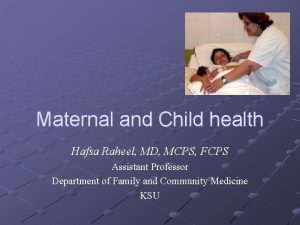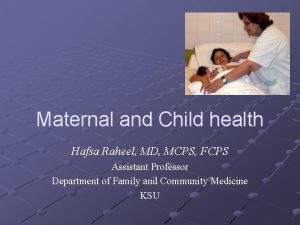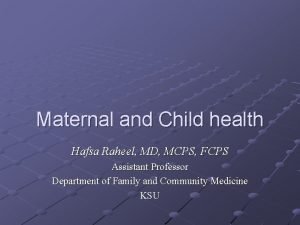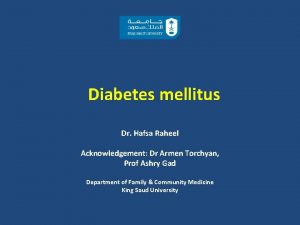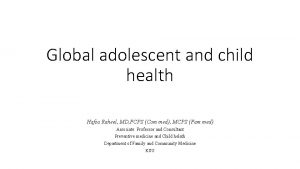HIVAIDS EPIDEMIOLOGY Dr Hafsa Raheel KSU Dept of




















































- Slides: 52

HIV/AIDS EPIDEMIOLOGY Dr. Hafsa Raheel KSU Dept of Family & Community Medicine

Objectives At the end of this lecture, the student should be able to: • Describe the current estimates of HIV / AIDS infection • Understand how people get infected with HIV • Appreciate the features which characterize the pandemic in the Eastern Mediterranean Region • Differentiate what could work best, as far as prevention & control efforts are concerned, in our Region 6/8/2021 HIV/AIDS Epidemiology 2

What is AIDS ? 6/8/2021 HIV/AIDS Epidemiology 3

What is AIDS ? Acquired Immuno-Deficiency Syndrome (AIDS) is a severe life-threatening clinical condition, first recognized as a distinct syndrome in 1981. This syndrome represents the late stage of infection with the Human Immuno-deficiency Virus (HIV), which often results in progressive damage of the immune and other organ systems, especially the central nervous system (CNS) 6/8/2021 HIV/AIDS Epidemiology 4

HIV/AIDS PANDEMIC: OVERALL FEATURES - Pandemic: all continents, all nations HIV has been isolated from ALL body fluids - There are only three modes of transmission 6/8/2021 HIV/AIDS Epidemiology 5

HIV/AIDS PANDEMIC: OVERALL FEATURES (Continued) - Incubation & communicability: long - Asymptomatic infected (incubating carriers) are capable of transmission of the infection - Impacts of infection: health, social, productivity, life expectancy, economic, overall development 6/8/2021 HIV/AIDS Epidemiology 6

HIV / AIDS Infectious Cycle

HIV/AIDS INFECTIOUS CYCLE -1 Agent: HIV retrovirus, target cell: T 4 lymphocyte Reservoir: humans (cases, carriers) Communicability increases with: STI, TB, addiction, repeated contaminated injections / transfusions, sexual promiscuity (frequency, multiple partners) Portal(s) of outlet: semen, vaginal secretions, blood, skin 6/8/2021 HIV/AIDS Epidemiology 8

HIV/AIDS INFECTIOUS CYCLE -2 Modes of transmission: • • • Sexual (90 %): hetero- , homo- , bi sexually. Parenteral (5 %): blood, IDU, skin-piercing Perinatal (4 %): during pregnancy, labor, milk Portal of inlet: according to transmission Susceptibility: general, more among high risk groups especially: TB & STI patients 6/8/2021 HIV/AIDS Epidemiology 9

HIV Transmission by Efficiency & Global Distribution Exposure Blood Transfusion Perinatal Sexual IV Drug Abuse Needle-prick 6/8/2021 Transmission Efficiency % > 90 20 - 45 0. 1 - 1. 0 0. 5 - 1. 0 < 0. 5 HIV/AIDS Epidemiology Global Distribution <1 4 90 5 <1 10

MODES OF HIV TRANSMISSION (Continued) There is no current evidence to suggest that HIV is transmitted by: w Casual contact w Respiratory route w Enteric route w Insects w Food/water 6/8/2021 w. Toilets w Swimming pools w Seats, door-knobs w Tears w Sharing eating utensils HIV/AIDS Epidemiology 11

Epidemiology 6/8/2021 HIV/AIDS Epidemiology 12

Summary of global HIV epidemic (2016)

People living with HIV by WHO region (2016)

Summary of global HIV epidemic (2016) Number of people living with HIV in 2016 People newly infected with HIV in 2016 Total 36. 7 million [30. 8 million – 42. 9 Adults million] Women 34. 5 million [28. 8 million – 40. 2 Men million] Children (<15 years) 17. 8 million [15. 4 million – 20. 3 million] 16. 7 million [14. 0 million – 19. 5 Total million] Adults 2. 1 million [1. 7 million – 2. 6 million] Children (<15 years) AIDS deaths in 2016 1. 8 million [1. 6 million – 2. 1 million] Total 1. 7 million [1. 4 million – 1. 9 million] Adults 160 000 [100 000 – 220 000] Children (<15 years) Source: UNAIDS/WHO estimates. 1. 0 million [830 000 – 1. 2 million] 890 000 [740 000 – 1. 1 million] 120 000 [79 000 – 160 000]

Number of people newly infected with HIV 19% 40% 90% Future targets UNAIDS/WHO estimates

Number of people dying from HIV 19% 40% 90% Future targets UNAIDS/WHO estimates

Number of people receiving antiretroviral treatment 19% 40% 90% Future targets UNAIDS/WHO estimates

HIV testing and care continuum (2016) UNAIDS/WHO estimates

6/8/2021 HIV/AIDS Epidemiology 20

Reasons? ?

HIV / AIDS in the EMR

HIV/AIDS PANDEMIC: EMR FEATURES -1 § Late introduction ( late 1980 s), slow progression § By end of 2007, reported low overall prevalence of 0. 2 % in EMR nations § Generalized epidemic (> 1 %): in Djibouti, Sudan, some parts of Somalia § Concentrated epidemic (> 5 %): among IDU in Iran, Libya, Pakistan § Age-gender distribution: predominantly affecting adult (91 %) males (71 %) § Modes: mainly heterosexual (77 %); IDU (11 %); blood transfusion (5 %), mother to child (2 %) 6/8/2021 HIV/AIDS Epidemiology 23

HIV AND AIDS IN THE MIDDLE EAST & NORTH AFRICA (MENA)

Percentage Change in the Annual Number of New HIV Infections by World Region, 2001 -2012 Source: UNAIDS, Global Report: UNAIDS Report on the Global AIDS Epidemic 2013 (New York: UNAIDS, 2013): Annex: Epidemiology. 6/8/2021 HIV/AIDS Epidemiology 25

6/8/2021 HIV/AIDS Epidemiology 26

6/8/2021 HIV/AIDS Epidemiology 27

6/8/2021 HIV/AIDS Epidemiology 28

HIV / AIDS Prevention & Control

HIV/AIDS Control Bodies Globally: UNAIDS (includes 10 UN agencies); IHRA (International Harm Reduction Association) Nationally: Mo. H- National AIDS Program (NAP), Multi-sectoral National AIDS Committee (NAC) including: health, education, higher education, information, Islamic Affairs, Sports & Youth Welfare, planning, finance, labor, defense, interior Non-governmental (civil service) organizations 6/8/2021 HIV/AIDS Epidemiology 30

Global initiative 6/8/2021 HIV/AIDS Epidemiology 31

Prevention in the EMR • MENA, there is still very limited access to HIV testing and counselling. For example, in Sudan, only one in five people living with HIV are aware of their status • Morocco, the integration of HTC into public health services has increased the number of people accessing testing services from 46, 000 in 2010 to 222, 620 people in 2012 • Lebanon, efforts to prevent the mother-to-child transmission of HIV have been undermined by a lack of testing services in combination with expensive referral systems, fears around testing, as well as a lack of awareness and stigma • HIV testing has been offered to women attending antenatal clinics in Oman since 2010, and has an acceptance rate of 99%. Along with the United Arab Emirates and Morocco, Oman has one of the highest testing coverages for pregnant women in the region. 6/8/2021 HIV/AIDS Epidemiology 32

Prevention in the EMR • Iran’s harm reduction programmes have been recognised as good practice in preventing the transmission of HIV among people who inject drugs • In the mid-2000 s, the government launched a campaign distributing clean needles and syringes in pharmaciesacross the country • In 2010, 5. 7% and 5. 9% of men who have sex with men in Cairo and Alexandria respectively were reported to be living with HIV. in these two cities, HIV prevention projects engage and enrol people belonging to key affected populations, particularly men who have sex with men. Upon enrolment, clients become part of a coding system that enables them to access subsidised HIV prevention services such as condoms and lubricants, HIV testing and counselling, medical services, psychosocial support, legal services as well as follow-up support. • Morocco combines condom distribution, outreach work and HIV testing with a strong online presence. In Marrakesh, there is a speciality clinic for men who have sex with men addressing issues such as sexual health and substance abuse 6/8/2021 HIV/AIDS Epidemiology 33

Prevention in the EMR • In Morocco, in 2012, a preventing mother-to-child transmission (PMTCT) programme. It includes efforts to engage private health providers to offer HIV testing and counselling (HTC) and HIV awareness for pregnant women. basic health facilities had been established to provide HTC services for pregnant women 6/8/2021 HIV/AIDS Epidemiology 34

Barriers to HIV prevention programmes in the Middle East and North Africa • Cultural and social barriers – religious and cultural values, which discourage pre-marital sex, encourage married people to be faithful, and emphasise universal male circumcision – some cultural practices exacerbate the spread of HIV including child marriage, polygamy and bans on condom use – gender inequality and the low status of women has meant that women and girls have been disproportionately affected by the epidemic – high levels of stigma and discrimination drive the epidemic in the region, preventing those living with HIV, and those at high risk of HIV transmission from seeking the treatment and support they need 6/8/2021 HIV/AIDS Epidemiology 35

Barriers to HIV prevention programs in the Middle East and North Africa • Political barriers: – political uprisings, Unrest and conflict disrupts • Legal barriers: – Punitive laws (homosexual acts are punishable by death, use and the possession of drugs are criminalised ) – Restrictions on entry, stay and residence (GCC countries) 6/8/2021 HIV/AIDS Epidemiology 36

To unify the strategy among the GCC countries that combat HIV/AIDS and motivate these countries to deal with HIV/AIDS in a way that goes in line with the global trend of HIV/AIDS prevention and control 6/8/2021 HIV/AIDS Epidemiology 37

HIV in Saudi Arabia 6/8/2021 HIV/AIDS Epidemiology 38

HIV in Saudi Arabia – HIV and AIDS estimates (2015) – – – 6/8/2021 Number of people living with HIV Adults aged 15 to 49 prevalence rate Adults aged 15 and over living with HIV Women aged 15 and over living with HIV Children aged 0 to 14 living with HIV Deaths due to AIDS HIV/AIDS Epidemiology N/A N/A N/A 39

Media and research reports http: //www. arabnews. com/news/485866 http: //saudigazette. com. sa/saudi-arabia/95 -saudi-women-got-aids-from-their -hubbies/ Sexual practices of young educated men: implications for further research and health education in Kingdom of Saudi Arabia (KSA). Hafsa Raheel, Muhammad Afzal Mahmood, Abdulaziz Bin. Saeed. Journal of Public Health | Vol. 35, No. 1, pp. 21 – 26 | doi: 10. 1093/pubmed/fds 055 | Advance Access Publication 1 August 2012 http: //jpubhealth. oxfordjournals. org/content/35/1/21. full. pdf+html 6/8/2021 HIV/AIDS Epidemiology 40

Mo. H - National AIDS Control Program, KSA • Established back in 1986, in response to the emergence of HIV pandemic • Responsible for defining and implementing strategies for preventive and control of HIV/AIDS/STI activities in KSA • Supported by different committees of experts in related aspects • Such program activities are integrated in existing national health system 6/8/2021 HIV/AIDS Epidemiology 41

6/8/2021 HIV/AIDS Epidemiology 42

General recommendations for HIV/AIDS prevention 6/8/2021 HIV/AIDS Epidemiology 43

HIV/AIDS Preventive Measures w Primary: Health education, preventing transmission w Secondary: health education, counseling, health care, support (avoid stigmatization, discrimination), protect society (public health measures) w Tertiary: care for the terminally ill, managing complications and associated conditions 6/8/2021 HIV/AIDS Epidemiology 44

AIDS management w Anti retroviral treatment (ART) w zidovudine + lamivudine w abacavir + zidovudine + lamivudine w lopinavir + ritonavir w abacavir + lamivudine w tenofovir/emtricitabine w efavirenz + tenofovir/emtricitabine w rilpivirine + tenofovir/emtricitabine w elvitegravir + cobicistat + tenofovir/emtricitabine 6/8/2021 HIV/AIDS Epidemiology 45

Target Groups for HIV/AIDS Preventive Measures w Vulnerable groups: youngsters & women (in general) but IDU, prisoners, TB & STI patients, homosexuals, prostitutes (in specific) w Other groups: migrant workers, refugees and displaced persons, transport workers, & tourists 6/8/2021 HIV/AIDS Epidemiology 46

HIV/AIDS Preventive Measures PREVENTION OF SEXUAL TRANSMISSION Global recommendations: abstinence, condom use EMR Recommendations: fostering religion, health education (curricula, information, skills, behavior) dealing with the problem as a social/health issue, use of mass media (advertisements, plays, dialogues) 6/8/2021 HIV/AIDS Epidemiology 47

HIV/AIDS Preventive Measures PREVENTION OF BLOOD TRANSMISSION u Safety measures & screening at every stage u Voluntary un-paid donors only u Transfusion, only when needed u Careful history-taking and physical examination 6/8/2021 HIV/AIDS Epidemiology 48

HIV/AIDS Preventive Measures PREVENTION OF PERINATAL TRANSMISSION w Pre-marital counseling w Infected women are advised not to conceive w Use of AZT ( reduces transmission risk by 2/3 ) w In general, breast feeding should be continued w Case-management: compulsory notification 6/8/2021 HIV/AIDS Epidemiology 49

AIDS must not be allowed to join the long list of problems, like poverty, hunger and ignorance, that the world has learnt to live with, because the powerful have lost interest, and the powerless have no choice. 6/8/2021 HIV/AIDS Epidemiology 50

References UNAIDS Report on the global AIDS epidemic. 2011. HIV and AIDS in Middle east and north Africa. http: //www. avert. org/professionals/hiv-around-world/middle-east-north-africamena • WHO EMRO: AIDS and Sexually Transmitted Diseases: http: //www. emro. who. int/asd/index. htm • WHO: HIV/AIDS: http: //www. who. int/gho/hiv/en/ • United Nation Development Program: Kingdom of Saudi Arabia: http: //www. undp. org. sa/sa/ • National AIDS Control Program: Saudi Arabia. www. unicef. org/gao/Saudi_1. ppt • Saudi Charity Association For AIDS Patients: http: //www. saca. org. sa/Action 1. htm • Raheel H et al. Sexual practices of young educated men: implications for further research and health education in Kingdom of Saudi Arabia (KSA). Journal of Public Health, 2012, pp. 1– 6 • Raheel H. Stigma towards People Living with HIV/AIDS (PLWAs) among Adolescents of Riyadh, Kingdom of Saudi Arabia. J AIDS Clin Res 2016, 7: 9 DOI: 6/8/2021 51 10. 4172/2155 -6113. 1000612 HIV/AIDS Epidemiology • •

6/8/2021 HIV/AIDS Epidemiology 52
 Raheel choudhary
Raheel choudhary Raheel choudhary
Raheel choudhary Hafsa riaz
Hafsa riaz Doç dr hafsa kesgin
Doç dr hafsa kesgin Employment first ohio
Employment first ohio Gome dept
Gome dept Department of agriculture consumer services
Department of agriculture consumer services Iit
Iit Central islip fire dept
Central islip fire dept Hoe dept
Hoe dept Mn dept of education
Mn dept of education La geaux biz
La geaux biz Florida dept of agriculture and consumer services
Florida dept of agriculture and consumer services Affiliation poster presentation
Affiliation poster presentation Gome dept
Gome dept Organizational structure of finance department
Organizational structure of finance department Dept ind onegov
Dept ind onegov Rowan county dss
Rowan county dss Pt dept logistik
Pt dept logistik Fire dept interview questions
Fire dept interview questions Liz welch mississippi
Liz welch mississippi Continuing education library oxford
Continuing education library oxford Florida dept of agriculture and consumer services
Florida dept of agriculture and consumer services Horizontal
Horizontal Vaginal dept
Vaginal dept Worcester ma building dept
Worcester ma building dept Albany county dept of social services
Albany county dept of social services Nys dept of homeland security
Nys dept of homeland security Dept of education
Dept of education Oviposition
Oviposition Dept. name of organization
Dept. name of organization Dept nmr spectroscopy
Dept nmr spectroscopy Nebraska dept of agriculture
Nebraska dept of agriculture Dept a
Dept a Gome dept
Gome dept Dept. name of organization (of affiliation)
Dept. name of organization (of affiliation) Affiliate disclodures
Affiliate disclodures Bromocicloesano
Bromocicloesano Dept of education
Dept of education Web of causation of disease
Web of causation of disease Descriptive epidemiology
Descriptive epidemiology Descriptive vs analytic epidemiology examples
Descriptive vs analytic epidemiology examples Seven uses of epidemiology
Seven uses of epidemiology Attack rate
Attack rate Distribution in epidemiology
Distribution in epidemiology Epidemiology
Epidemiology What is descriptive study in epidemiology
What is descriptive study in epidemiology Association vs causality
Association vs causality Advantages and disadvantages of nutritional epidemiology
Advantages and disadvantages of nutritional epidemiology How dr. wafaa elsadr epidemiology professor
How dr. wafaa elsadr epidemiology professor Diabetic ketoacidosis epidemiology
Diabetic ketoacidosis epidemiology Defination of epidemiology
Defination of epidemiology Descriptive vs analytical epidemiology
Descriptive vs analytical epidemiology










































